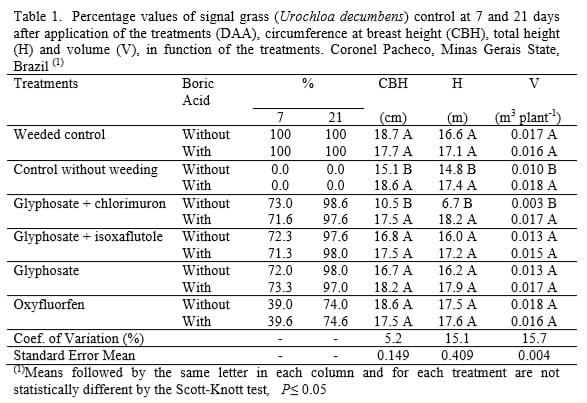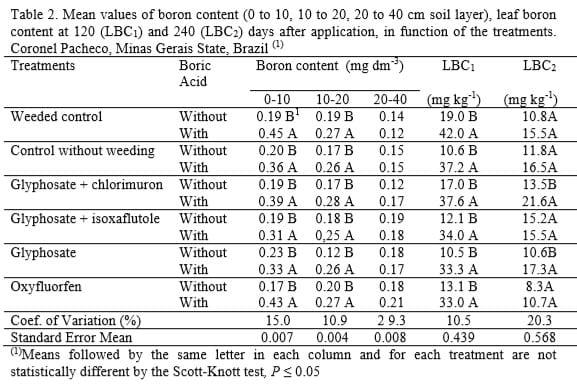Introduction
Silvopastoral systems have attracted the interest of farmers as an alternative to improve the physical and chemical properties of the soil, as well as the benefits related to the quality of the forage and weight gain of the animals. However, the establishment of the silvopastoral systems depends on an efficient weed control until the trees have grown enough to be away from weed and grass competition. In relation to eucalyptus, weed competition causes mainly reduction of the stem diameter and of the dry matter of stems and shoots. Another fact that should be considered in the implementation of trees is the aspect related to the mineral nutrition of plants. Recently, eucalyptus genotypes have been developed increasing more production, and therefore more demanding in terms of nutrition. Attention should be directed not only to the macronutrients but also micronutrients, particularly boron. The lack of B leads in inhibition of plant growth, due to the fact that this micronutrient is part of the cell wall. In its absence, there is a reduction in the synthesis of pectin, cellulose and lignin in the wood cell walls, making them thinner. The deficiency of boron on eucalyptus is called dry of the pointer. Thus, operations that can control weeds and provide boron, at the same time, allow to reduce production costs and ensure the establishment of the eucalyptus. The present study was undertaken to evaluate the weed control in the rows of eucalyptus with herbicides applied either alone or combined with boron, as well as, the response of eucalyptus plants to this micronutrient.
Material and Methods
The experiment was carried out in Coronel Pacheco, Minas Gerais State, Brazil (210 54' 69'' S and 430 26' 110'' W). The experimental design was a split-plot with randomized complete block, with four replicates. Six treatments were applied to the plots: (i) weeded control, (ii) control without weeding, (iii) glyphosate (1080 g ae ha-1) + chlorimuron-ethyl (10 g ai ha-1) + 0.05% v / v mineral oil, (iv) glyphosate (1080 g ae ha-1) + isoxaflutole (112.5 g ai ha-1), (v) glyphosate (1080 g ae ha-1) and (vi) oxyfluorfen (480 g ai ha-1). Subplots were consisted of absence or presence of 4 kg of boric acid (H3BO3 - 17% B) in 100 L of water. The Eucalyptus urograndis (AEC-1528 commercial clone) was planted in a silvopastoral system on November 16, 2011. The applications of the treatments were performed on December 1, 2011 when eucalyptus plant height was approximately 0.4 m. It was used a sprayer (Herbicat Ltda, Catanduva, São Paulo, Brazil), with 296 kPa and maintained by compressed CO2. The sprayer was equipped with a 1.0 m wide bar and two plane jet spraying nozzles (110 01 AVI), 0.5 m apart from each other, with a spraying volume equivalent to 90 L ha-1. Prior the application, samples of the spray solution were collected and taken to the laboratory for pH determination. The application was performed on signal grass plants, to 1.0 m wide, from each side of the eucalyptus rows without reaching the trees. Visual injury ratings on signal grass were obtained 7 and 21 days after application (DAA), using the scale 0-100% (Gazziero et al., 1995). The circumference at breast height (CBH) (cm) and the total height (m) were measured using a metric tape and an Abney clinometer, respectively. The CBH was divided by pi (3.14159) to obtain the diameter at breast height. The volume per tree was obtained using the form factor of 0.4. These measurements were performed at six months after the application of treatments. Soil samples were taken from each subplot in the 0-10, 10-20 and 20-40 cm soil layer at 120 DAA for boron content determination. The analyses were made in BaCl2 5 mmol L-1. Eucalyptus leaves were collected at 120 and 240 DAA to determine the levels of boron. Statistical analyses were performed using SAEG program (Ribeiro Júnior, 2001). Data were submitted to analysis of variance and means were compared by the Scott-Knott test, p ≤ 0.05.
Results and Discussion
There were no significant interactions between factors of control treatments and the addition or not of boron source for the variables percentage of control at 7 and 21 DAA (Table 1). The treatments with glyphosate applied singly or in combination with boric acid provided results of percentages of signal grass control of 73% at 7 DAA. The addition of boric acid in the spray solution did not affect the efficacy of glyphosate in controlling signal grass. The symptoms were characterized by leaf chlorosis with progression to necrosis and death of leaves at 21 DAA, keeping the tree rows free of signal grass in 1m on each side of the eucalyptus plants. Eucalyptus plants grown with fixed control ranges from 1m on each side of the crop row proved superior diameter at breast height, height and volume compared to plants grown to 0.5m (Toledo et al., 2003). A reduction in spray solution pH occurred when glyphosate was added to the water, decreasing from 6.6 to 4.8, on average. This decrease was even greater with addition of boric acid (pH = 4.5). Under this condition, the non-ionic form of herbicide molecules prevails, rapidly passing through the plasmatic membrane of the cells. This fact can be confirmed by the efficacy of the glyphosate in controlling signal grass plants. For the oxyfluorfen, the values of signal grass control were low. These values ranged from 39% at first evaluation to approximately 75% at 21 DAA (Tables 1).
This fact occurred because the effectiveness of this herbicide applied on post emergence is dependent on the growth stage of the weeds at the application time. At the moment of the application, the signal grass plants had many tillers per plant, affecting the efficacy of the oxyfluorfen. The values of circumference at breast height, total height and volume increased by the addition of boric acid in treatments involving control without weeding and glyphosate plus chlorimuron-ethyl (Table 1). There were significant interactions between factors of boron content in the soil (0-10 and 10-20 cm soil layer) and the addition or not of boric acid (Tables 2).


The treatments with addition of boric acid resulted in increase of boron in the 0-10 cm soil layer. The means values were 0.19 mg dm-3 on treatments without boric acid and 0.37 mg dm3 with the addition of boric acid. Increments on boron content were also observed in the depth of 10-20 cm. However, there were no increments on boron content in 20 to 40 cm soil depth. The analysis of leaf boron contents showed increases in B levels in treatments that received boric acid (Tables 2). The means values were 13.71 mg kg-1 on treatments without boric acid and 36.19 mg kg-1 with the addition of boric acid. Increments on boron content were also observed at 240 DAA with the addition of boron. Visual symptoms of dry of the pointer were observed on new tissues of the aerial part of eucalyptus plants in treatments which did not receive the boron source. The youngest leaves from the apex of the plants were characterized by malformation and reddish, with subsequent necrosis and drop. Symptoms of boron deficiency in young tissues indicate that boron is immobile in phloem for the majority of species (Epstein and Bloom, 2005).
Conclusions
The addition of boric acid in the solution containing the herbicides did not affect the weed control. There was an increase in boron content in the soil and consequently an increase in the boron levels in the eucalyptus leaves. The combined application of herbicides plus boric acid is perfectly suitable for preventing dry of the pointer on eucalyptus plants.
Aknowledgements
This work was supported by FAPEMIG (Fundação de Amparo à Pesquisa do Estado de Minas Gerais) and CNPq (Conselho Nacional de Desenvolvimento Científico e Tecnológico).
References
Epstein, E.; Bloom, A.J. 2005. Mineral nutrition of plants: principles and perspectives. Sunderland: Sinauer Associates,. pp. 400.
Gazziero, D.L.P; Velini, E.D.; Osipe, R. 1995. Procedimentos para instalação, avaliação e análise de experimentos com herbicidas. Londrina: Sociedade Brasileira da Ciência das Plantas Daninhas. pp. 42.
Ribeiro Junior, J.I. 2001. Análises estatísticas no SAEG. Viçosa: Universidade Federal de Viçosa, Viçosa, pp. 301.
Toledo, R.E.B.; Victória Filho, R.; Alves, P.L.C.A.; Pitelli, R.A.; Lopes, M.A.F. 2003. Faixas de controle de plantas daninhas e seus reflexos no crescimento de plantas de eucalipto. Scientia Forestalis, 64:78-92.







.jpg&w=3840&q=75)